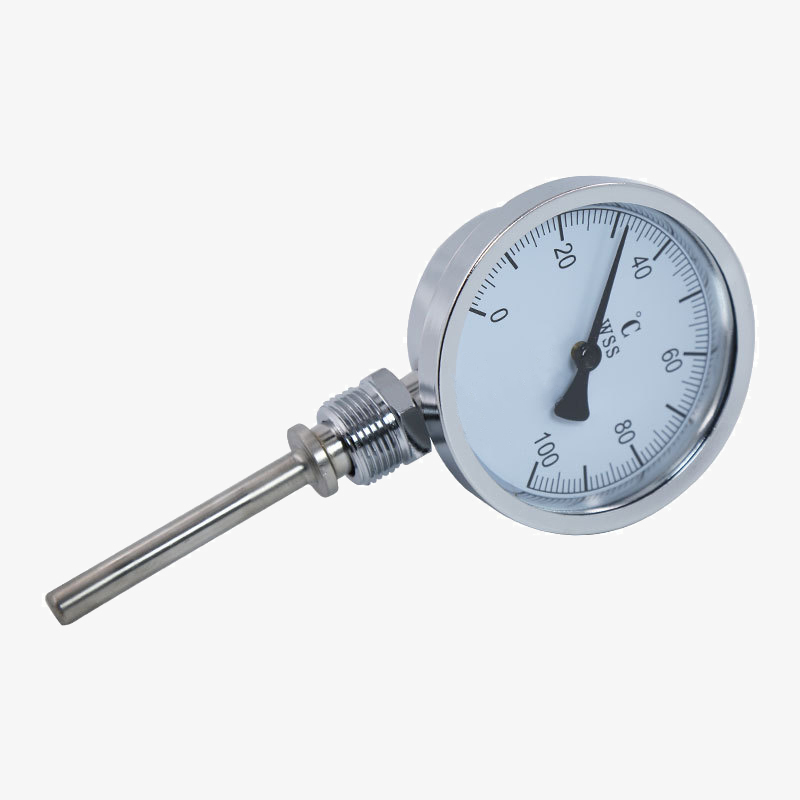sisco bimetallic thermometer is a temperature measurement device that is fully mechanical and does not require any power source to operate. Hot selling bimetallic temperature gauge provides 0~250℃ range, dial diameter 100mm, M27 thread, simple and robust design, high precision, long service life. It is a kind of dial thermometer, ideal for air conditioners, ovens, and industrial devices like heaters, hot wires, refineries, etc.

- Simple and robust design.
- Less expensive than other thermometers.
- Bimetallic thermometers are fully mechanical and do not require any power source to operate.
- Easy installation and maintenance.
- Nearly linear response to temperature change.
- High precision bimetallic temperature gauge is suitable for 0~250℃ wide temperature ranges.
- The pointer of the bimetallic thermometer covers 1/3, -2/3 of the length of the shortest graduation line.
Applications
Bimetallic thermometers can directly measure the temperature of liquid, steam and gas media and solid surfaces in the atmosphere of 0°C~300°C in various production processes, and are widely used in petroleum, chemical, metallurgy, textile, food and other industries.

- Model: SISCO-BR-WS411
- Range: 0~250℃
- Material: Aluminum Shell
- Thread Size: M27*2
- Dial Diameter: Φ100mm
- Accuracy: 1.5
Note: The default thread is M27*2, and the default probe length is 100mm. Thread and probe sizes can be customized. If you need other sizes, please contact us.
Q1: What is a bimetallic thermometer?
A1: The bimetallic thermometer is a field detection instrument for measuring low and medium temperatures. The bimetallic thermometer can directly measure the temperature of liquid, steam and gas mediums in the range of 0℃~300℃ in various production processes.
Q2: How does a bimetallic thermometer work?
A2: The bimetallic thermometer is a thermal bimetallic sheet wound into a spiral shape as a temperature sensing device, and it is installed in a protective sleeve. One end is fixed, called the fixed end, and the other end is connected to a thin shaft, called the fixed end. free end. A pointer is mounted on the free-end spool. When the temperature changes, the free end of the temperature-sensing device rotates accordingly, driving the pointer on the thin shaft to change the angle, and indicating the corresponding temperature on the dial. This is how bimetallic thermometers work.
Q3: Advantages of Bimetallic Thermometers
A3: The biggest advantage of the bimetal thermometer is that it has good shock resistance and is sturdy, but its accuracy is low and can only be used in industry, with an accuracy grade of 1 to 2.5. The bimetallic thermometer is suitable for medium and low-temperature on-site detection. It can directly measure the temperature of gas, steam and liquid, with clear indication and good mechanical strength.
Tips: Bimetallic Thermometers in Home Applications
In household use, bimetallic thermometers can measure the temperature of the center of food, such as cooking soup, grilled meat, hand-made coffee, the temperature inside the oven, and the temperature of the indoor environment.
Thank you for buying industrial test and measurement equipment on SISCO.com, all products sold by SISCO and the partner cover a 12 months warranty, effective from the date of receiving the products.
What is covered?
SISCO is responsible for providing free spare parts, and free technical support to assist the customer to repair the defective products until the problem is solved.
What is not covered?
- Product purchased from anyone other than a SISCO store or a SISCO authorized reseller.
- Expendable parts.
- Routine cleaning or normal cosmetic and mechanical wear.
- Damage from misuse, abuse or neglect.
- Damage from use of parts other than SISCO approved.
- Damage from use outside the product’s usage or storage parameters.
- Damage from use of parts not sold by SISCO.
- Damage from modification or incorporation into other products.
- Damage from repair or replacement of warranted parts by a service provider other than a SISCO authorized service provider.
- Damage caused by the application environment not meeting the product usage requirements and the failure to perform preventive maintenance.

